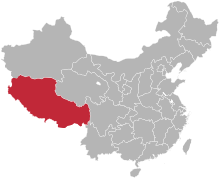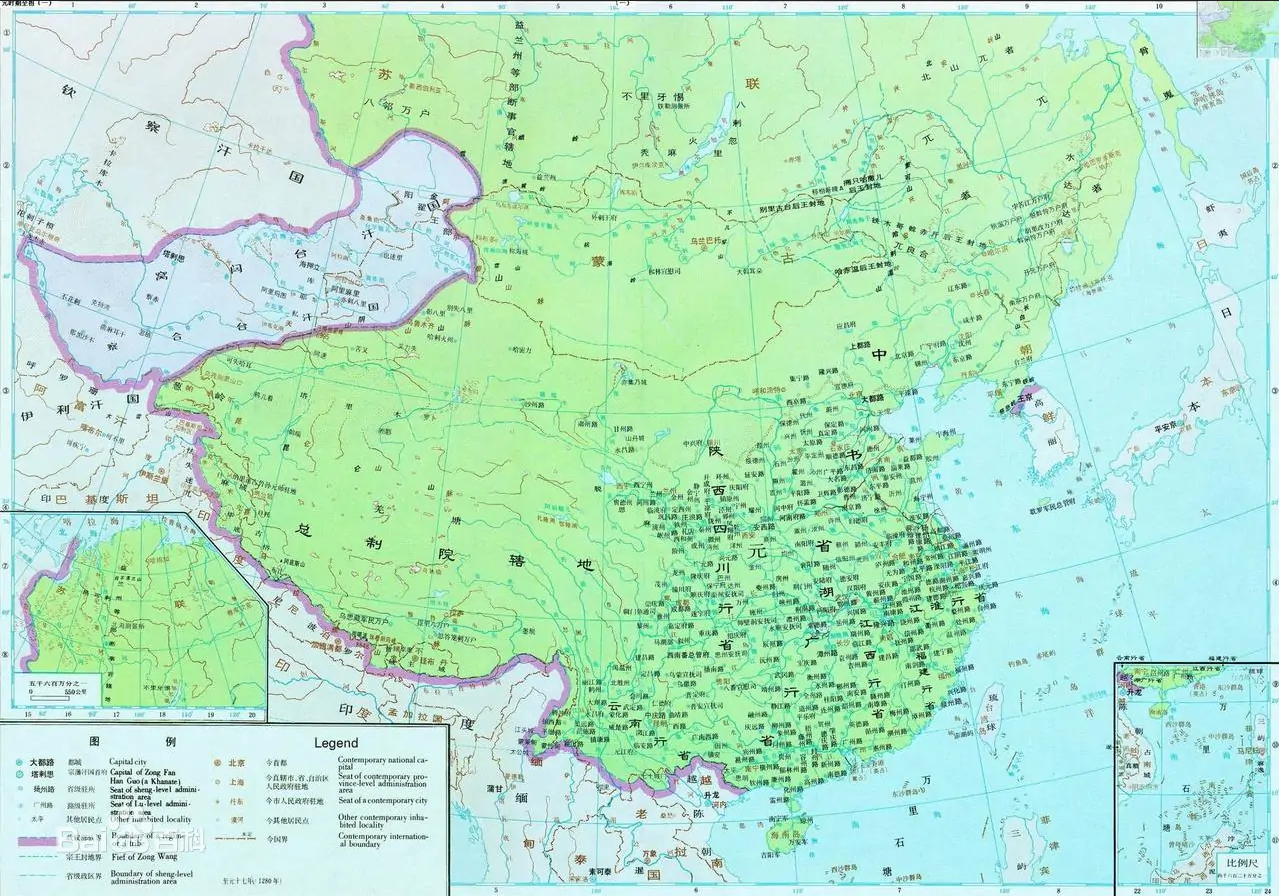More languages
More actions
No edit summary Tag: Visual edit |
m (added mount everest in parentheses just in case for people who don't know about native pronounciation) Tag: Visual edit |
||
| Line 1: | Line 1: | ||
{{Infobox settlement|native_name=西藏自治区; བོད་རང་སྐྱོང་ལྗོངས།|leader_title2=Director of the Standing Committee of the People's Congress|capital=[[Lhasa]]|leader_name4=Pabala Gelielangjie|leader_name3=Qi Zha La|leader_title4=Chairman of the CPPCC|leader_title3=Chairman of the People's Government|leader_name2=Luosang Jiangcun|leader_name1=Wu Yingjie|conventional_long_name=Tibet Autonomous Region|leader_title1=Party Secretary|GDP_nominal=USD $29,736,351,796|population_estimate=3,648,100|area_km2=1,228,400|settlement_type=Autonomous Region|image_map_size=220px|image_map=Tibet map.svg|largest_city=[[Lhasa]]}} | {{Infobox settlement|native_name=西藏自治区; བོད་རང་སྐྱོང་ལྗོངས།|leader_title2=Director of the Standing Committee of the People's Congress|capital=[[Lhasa]]|leader_name4=Pabala Gelielangjie|leader_name3=Qi Zha La|leader_title4=Chairman of the CPPCC|leader_title3=Chairman of the People's Government|leader_name2=Luosang Jiangcun|leader_name1=Wu Yingjie|conventional_long_name=Tibet Autonomous Region|leader_title1=Party Secretary|GDP_nominal=USD $29,736,351,796|population_estimate=3,648,100|area_km2=1,228,400|settlement_type=Autonomous Region|image_map_size=220px|image_map=Tibet map.svg|largest_city=[[Lhasa]]}} | ||
The '''Tibet Autonomous Region''' (Chinese: 西藏自治区; Tibetan: བོད་རང་སྐྱོང་ལྗོངས།), also known as '''Tibet''' (西藏; བོད), is an province-level autonomous region in southwest [[People's Republic of China|China]]. It is home to the Tibetan ethnic group and the Tibetic languages, which are a branch of the Chinese language family Sino-Tibetan. The autonomous region covers most of what is known as the Tibetan plateau, which is the origin of some of the most important rivers in the world, including the Brahmaputra, Yangtze, Mekong, Indus, and Yellow rivers. Tibet also contains many tall mountains including Mount Qomolangma, the tallest in the world. | The '''Tibet Autonomous Region''' (Chinese: 西藏自治区; Tibetan: བོད་རང་སྐྱོང་ལྗོངས།), also known as '''Tibet''' (西藏; བོད), is an province-level autonomous region in southwest [[People's Republic of China|China]]. It is home to the Tibetan ethnic group and the Tibetic languages, which are a branch of the Chinese language family Sino-Tibetan. The autonomous region covers most of what is known as the Tibetan plateau, which is the origin of some of the most important rivers in the world, including the Brahmaputra, Yangtze, Mekong, Indus, and Yellow rivers. Tibet also contains many tall mountains including Mount Qomolangma (known as Mount Everest in the West), the tallest in the world. | ||
==History== | ==History== | ||
Revision as of 00:02, 10 December 2022
Tibet Autonomous Region 西藏自治区; བོད་རང་སྐྱོང་ལྗོངས། | |
|---|---|
Autonomous Region | |
 | |
| Capital and largest city | Lhasa |
| Government | |
• Party Secretary | Wu Yingjie |
• Director of the Standing Committee of the People's Congress | Luosang Jiangcun |
• Chairman of the People's Government | Qi Zha La |
• Chairman of the CPPCC | Pabala Gelielangjie |
| Area | |
• Total | 1,228,400 km² |
| Population | |
• Estimate | 3,648,100 |
| GDP (nominal) | estimate |
• Total | USD $29,736,351,796 |
The Tibet Autonomous Region (Chinese: 西藏自治区; Tibetan: བོད་རང་སྐྱོང་ལྗོངས།), also known as Tibet (西藏; བོད), is an province-level autonomous region in southwest China. It is home to the Tibetan ethnic group and the Tibetic languages, which are a branch of the Chinese language family Sino-Tibetan. The autonomous region covers most of what is known as the Tibetan plateau, which is the origin of some of the most important rivers in the world, including the Brahmaputra, Yangtze, Mekong, Indus, and Yellow rivers. Tibet also contains many tall mountains including Mount Qomolangma (known as Mount Everest in the West), the tallest in the world.
History
Ancient history
Tibet first became part of the Tang dynasty in 640 AD. There is a statue of the Tang Princess Wen Cheng in the Potala Palace, Lhasa, which was erected in 641 after she married the Tibetan King Songtsen Gampo. The Tang-Tibet Alliance Monument erected in 823 still stands in the square in front of the Jokhang Monastery.[1]

In 1206, Genghis Khan, leader of the Mongols, established the Mongol Khanate in northern China. In 1247 Sakya Pandita Kunga Gyeltsen, religious leader of Tibet, met the Mongol Prince Godan Khan to decide on terms for Tibetan submission to the Mongols.[1] When Möngke Khan died in 1259, the empire was divided into 4 parts which were to be controlled by his sons. The Yuan Dynasty was the partition controlled by Kublai Khan and is the descendant of the modern Chinese state.
British imperialism
After the British imperialists started the Opium War in 1840, China was reduced from an independent sovereign country to a semi-colonial country. Imperialist forces took advantage of the weak Qing Dynasty and began to carve up China, Tibet included.[2]
British aggressors invaded Tibet twice in 1888 and 1903. After the second invasion, the invaders compelled the local government to sign the Lhasa Convention, but the Qing high commissioner stationed in Tibet refused to sign it.[2]
In 1911, the people of China rose up and overthrew the Qing dynasty, establishing the Republic of China. The Republic of China government was incredibly weak, and the western powers who had occupied the Qing resisted. Britain put before the Chinese Ministry of Foreign Affairs a five-point demand, indicating the denial of China's sovereignty over Tibet. When the Chinese government rejected the British demand, the British blocked all the roads leading from the British Raj in India to Tibet.[2]
In 1913 the British government coerced local Tibetan authorities into declaring independence and proposed that:
- "Britain be the weaponry supplier after total independence of Tibet;"
- "Tibet accept British envoys' supervision of Tibetan financial and military affairs in return for Britain's support of Tibetan independence;"
- "Britain be responsible for resisting the army of the Republic of China when it reaches Tibet;"
- "Tibet adopt an open policy and allow freedom of movement of the British."[3]
Tibetan theocracy
In feudal Tibet, most of the rural population were serfs who had no education or healthcare. Only 2% of children attended school, the life expectancy at the end of feudalism was 35.5 years, and the infant mortality rate was 43%.[4] While the Dalai Lama lived in the 14-story Potala Palace with 1,000 rooms,[5] 95% of Tibetans were serfs. Most households had to eat grass and cow bones to survive at times.[4]
Torture and mutilation were commonly used against serfs and the majority of serfs' production was owed to the feudal lord.[4] Young peasant boys were often sexually abused in monasteries and serf girls were used as house servants.[5]
People's Republic of China
In 1951, after successfully taking back many other lawless parts of China, the PLA reached Tibet and regained control over it without any clashes. They soon began education and healthcare programs. In 1950, construction began on the first two roads in Tibet. The Chinese government was cautious with reforms and the priesthood still controlled most of Tibet's wealth in 1959.[4]
On 1959 March 10, the Dalai Lama and feudal nobility attempted a counterrevolution.The Dalai Lama's brother, Gyalo Thondup, worked with the CIA to establish a guerrilla unit that parachuted into Tibet. Many of them were chiefs of aristocratic clans or their relatives and 90% were never seen again. The uprising ended quickly and the Dalai Lama fled to India.[5]
In 1965, the First People's Congress of Tibet was held and the regional government of Tibet was founded.
By 2002, infant mortality had dropped to under 2% and the per capita number of hospital beds and medical personnel is higher than the average in China. Over 85% of school-age children attended school.[4]
In 2008, ethnic Han and Hui people were targeted in race riots in Lhasa.[6]
References
- ↑ 1.0 1.1 "Ownership of Tibet" (1992).
- ↑ 2.0 2.1 2.2 "Origins of So-Called 'Tibetan Independence'" (1992).
- ↑ 朱绣 (1996). 西藏六十年大事记. ISBN 9787225012223
- ↑ 4.0 4.1 4.2 4.3 4.4 "China, Tibet and U.S.-sponsored counterrevolution" (2008-04-01). Liberation School. Archived from the original on 2021-06-19. Retrieved 2022-06-20.
- ↑ 5.0 5.1 5.2 Michael Parenti (2020-12-26). "Friendly Feudalism: The Tibet Myth (2007)" Red Sails. Archived from the original on 2022-01-18. Retrieved 2022-04-24.
- ↑ Gwydion M. Williams. "The Tibetan Race Riots of 2008" Long Revolution. Retrieved 2022-04-24.
